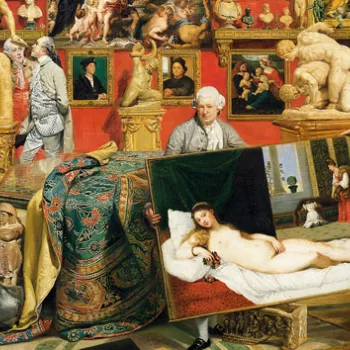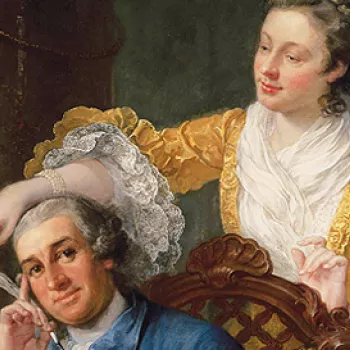A Dinner Party c. 1719-25
Oil on canvas | 90.8 x 85.8 cm (support, canvas/panel/stretcher external) | RCIN 403539
-
Marcel Lauron was a French painter who had settled in The Hague in Holland in the mid-seventeenth century. He moved to England sometime before 1674, accompanied by his son, Marcellus Lauron (1653-1702). By 1680 Marcellus had married an Englishwoman and settled in London, where his son, Marcellus II Laroon, the author of this work, was born in 1679. Laroon the Younger travelled in Italy, France and Holland, and served for many years as a soldier, before taking up painting, specialising in scenes of this type.
A drawing for this composition is signed and dated 1719 and inscribed ‘Premiere Pensée / presented to King George 1st / a picture I painted in 1725'. This provides a date for the painting, but not an identification of the sitters. The fact that the host is wearing the ribbon of the Order of the Garter has taken to imply that such an identification should be possible, and various names have been suggested. However, none of Laroon’s scenes of fashionable life have figures which can be identified, which suggests that they were never intended to be portraits. Furthermore, there is no reason why a fictitious character may not be a Garter knight, particularly as the scene is full of the exaggerated expressions and ludicrous physiognomies of a stage comedy. This is surely a satire on the manners of the fashionable elite of the day; even the curtain raised to reveal the scene is a theatrical property. It is no doubt significant that Laroon himself was a distinguished amateur actor and musician.
We are to imagine that the dinner guests have left the main house during the meal and proceeded to the ‘banquet-house’ for sweets. Through the open door we can see glimpses of wrought iron decorated with the host’s coronet, which also appears with the gilded phoenix above the mirror. The arched space for the buffet is reminiscent of the open pavilion architecture employed by Watteau. At the table, members of the company are served jellies and fruit with white and red wine. We must imagine that a contemporary audience would have read the characters (and distinguished guest from servant) better than we can, but the following episodes can be proposed (many of necessity conjectural). At the extreme left a red-faced gardener tries to scrounge some wine from a servant; two grave-looking characters standing to their left hold plates and could be servants or guests; a young Black man wears a silver collar implying he is enslaved; a fat clergyman looks straight out at the viewer, his shiny round face and apple-cheeks like a toby jug, seeming to symbolise the mood of worldly satisfaction. Seated around the table we see a lady taking snuff to the left, entertained by a milk-sop; the lady next to him has captured the attention of her lover, a solemn wedge-faced man, his nose glued to her ear as he whispers sweet nothings; at the head of the table the host pours wine with a flourish, presumably letting it breathe. The servant boy, holding a tray of wine glasses and casting knowing look at the viewer, has a springing gait echoing the dog behind him, suggesting that he is an ‘insolent young puppy’.
For a scene of high fashion the figures here seem to be very simply dressed. It was the fashion during these years in England to use less brocade on coats made of subtle colours, which gave rise to the frequent complaint of French visitors that in England one could not tell servants from their masters. The writer and spy John Macky (d. 1726) noted that:
‘The dress of the English is like the French but not so gaudy; they generally go plain but in the best cloths and stuffs . . . not but that they wear embroidery and laces on their cloathes on solemn days, but they dont make it their daily wear, as the French do.’ (A Journey through England, 1722)
Text adapted from The Conversation Piece: Scenes of fashionable life, London, 2009Provenance
First recorded in Queen Caroline's Dressing Room at Kensington Palace in 1818 (no 505); in the Prince of Wales's Drawing Room at Hampton Court in 1861 (no 606)
-
Creator(s)
-
Medium and techniques
Oil on canvas
Measurements
90.8 x 85.8 cm (support, canvas/panel/stretcher external)
102.4 x 97.4 x 5.7 cm (frame, external)
Category
Object type(s)











